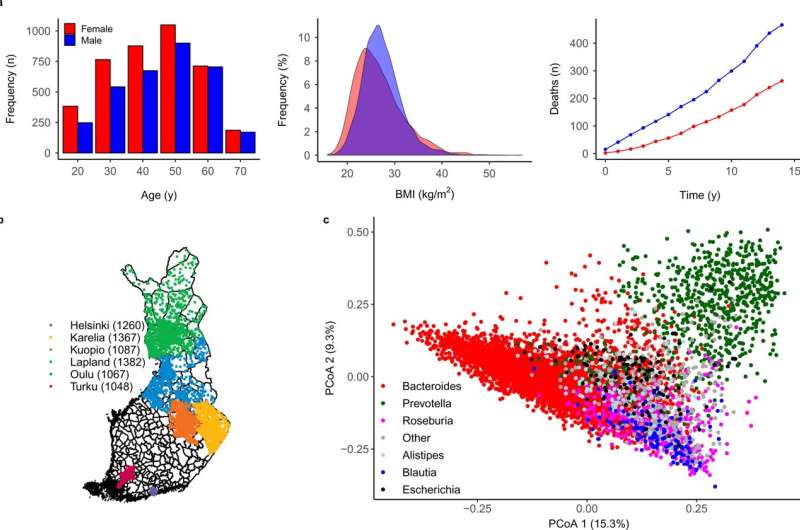Fig. 1: Study sample and gut microbiome characteristics. a At baseline, the study sample (n = 7211) had a balanced sex ratio (55% women in red:men in blue), a mean age of 49 years (range 24–74; left panel) and a mean body mass index (BMI) of 27 kg/m2 (range 16–57; middle panel). During a median follow-up time of 14.8 years, 721 of 7055 (10.2%) participants with complete data who were included in the prospective analysis died (right panel). b A total of 7211 out of 13,500 randomly sampled individuals (53.4% participation rate) from six catchment areas in Finland underwent stool sampling, a physical examination and filled in a questionnaire on health behaviour, history of diseases and current health. c Principal coordinate analysis (PCoA) indicates sample similarity based on species-level taxonomic composition. The colour indicates the dominant (most abundant) genus in each sample. Altogether, 96% of the samples are dominated by one of the six genera that are indicated in the figure. Credit: Nature Communications (2021). DOI: 10.1038/s41467-021-22962-y
Researchers discovered that a large amount of enterobacteria in the gut microbiota is related to long-term mortality risk in Finnish adult population.
The study conducted by the University of Turku and the Finnish Institute for Health and Welfare together with an international research team is so far the largest population-level study in the world examining the connection between human gut microbiota and health and mortality in the following decades.
The composition of the research subjects' gut microbiota was analyzed from stool samples collected in 2002. The researchers had access to follow-up data on the subjects' mortality until 2017, i.e., close to the present day.
"Many bacterial strains that are known to be harmful were among the enterobacteria predicting mortality, and our lifestyle choices can have an impact on their amount in the gut. By studying the composition of the gut microbiota, we could improve mortality prediction, even while taking into account other relevant risk factors, such as smoking and obesity. The data used in this research make it possible for the first time to study the long-term health impact of the human gut microbiota on a population level," says Teemu Niiranen, Professor of Medicine at the University of Turku, Finland.
Everyone has a unique microbiota
Human microbiota is highly individual and consists of a vast amount of different bacteria and other microorganisms. The bacteria predicting a shorter lifespan were discovered when the researchers compared health records and billions of DNA strands retrieved from the research subjects' microbiota.
"We developed a machine learning algorithm that screened the data for microbial species having a significant association with mortality among the research subjects in the following two decades after the sample was taken," says Associate Professor Leo Lahti from the University of Turku.
"Finnish population studies are unique in their extent and scope even on a global scale. With new data science methods, we are now able to study more closely the specific connections between microbiota and, for example, aging and incidence of common diseases," Lahti continues.
Even though the connection between gut microbiota and lifestyle has lately been studied extensively in cross-sectional studies, there are only a few long-term follow-up studies available. Therefore, only a small amount of information has been gained about the connection between microbiota and health in the long term.
The research article was published in Nature Communications.
More information: Aaro Salosensaari et al. Taxonomic signatures of cause-specific mortality risk in human gut microbiome, Nature Communications (2021). DOI: 10.1038/s41467-021-22962-y
Journal information: Nature Communications
Provided by University of Turku























